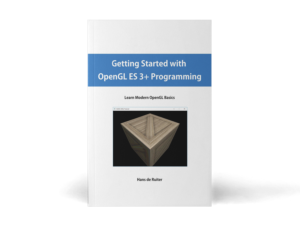Description
There are plenty of tutorials out there that teach how to program graphics cards to generate imagery. However, simply following tutorials alone will only get you so far.
Understanding how a Graphics Processing Unit (GPU) works and the theory they’re built on will
Unlock the Secrets of Graphics Programming Mastery with the “Modern Graphics Programming Primer!”
It seems like there are only options for learning graphics programming: tutorials that only scratch the surface, and huge “teach you everything” graphics programming books that are completely overwhelming. Following tutorials alone will only get you so far, while the huge books bog you down with details so much, that mastering anything feels impossible.
Kickstart your path to graphics programming mastery with this deliberately short yet to-the-point and focused e-book. Learn how Graphics Processing Units (GPUs) work, and the theory they’re built on. Then you’ll be able to think creatively instead of blindly following tutorials.
What’s Inside
The e-book doesn’t try to cover everything in full detail. Instead, it covers the core fundamentals you need to get started:
- Explore the inner workings of the graphics pipeline, demystifying shaders, data buffers, etc.
- Learn 3D camera and object positioning using matrix algebra
- Grasp the fundamentals of simulating lighting in 3D (via the Phong lighting model)
- Performance tips and tricks to optimize your graphics engine’s performance
- A cheat-sheet for common tasks using OpenGL ES 3, SDL2, and GLM
- A curated list of useful resources to deepen your knowledge and expand your expertise beyond what’s covered in the book
What’s NOT inside
You’ll be grateful that there are:
- No obtuse math equations that’ll confuse you before you get so much as a triangle on screen
- No heavy jargon loaded prose written for academics. Concepts are written in layman’s terms so you won’t need a computer science degree to just understand it
- No super advanced lighting techniques that look awesome, but are far out of reach to beginners. This book is laser focused on what you need to get started. You can learn advanced techniques later, after you’ve mastered the fundamentals
- Vulkan, Mantle or any other modern but insanely complex graphics APIs. Yes, these advanced APIs can achieve awesome results, but that power comes with great (mind-bending) complexity. They’re NOT beginner friendly. The concepts in this book are fundamental, and can be used with any API
Also Included
This e-book comes with a companion “Getting Started with OpenGL ES 3+ Programming” tutorial series. These hands-on tutorials cover the practical “how-to” side; taking you from zero to rendering a basic 3D scene with lighting.
Check out the tutorials for free (link).
What Others Are Saying
One word; Superb!
Good introduction to 3D development
It gives the reader a good overview of the basics, enough to get started.
Good: Example code makes it easy to get started
A crucial good thing is the tutorials w/example code that compiles (those you provided on your keasigmadelta webpage).
This gives the reader good opportunities to succeed.
Other authors often forget this, leaving the reader «in the dark» by struggling with quirks, and ends up by giving up.
Having example code available is an excellent way of teaching. It’s easy to get started this way.
Good: Balanced detail level & informative
It has a good combination of programming details & explanations.
Good: Chapter about texture mapping
Easy understandable & informative illustration, combined with good explanations.
Good: Chapter about Performance optimizing
Optimization is important to me, and getting this information in this book is crucial for me.
This means the readers can obtain healthy programming habits from the beginning.
— Jostein Aarbakk
About the Author
Hans de Ruiter is a software engineer with a background in computer vision and graphics. As a child/teenager he taught himself programming, constructed electronic circuits from kitsets, and also had a keen interest both science and in building things himself. He persued these interests further at university, going all the way through to a Ph.D. (at the University of Toronto).
He’s written both graphics software and graphics drivers, giving him a broad understanding of how modern graphics cards work.



Leave feedback about this